Yan Zhong
Exploring Category-level Articulated Object Pose Tracking on SE(3) Manifolds
Nov 08, 2025Abstract:Articulated objects are prevalent in daily life and robotic manipulation tasks. However, compared to rigid objects, pose tracking for articulated objects remains an underexplored problem due to their inherent kinematic constraints. To address these challenges, this work proposes a novel point-pair-based pose tracking framework, termed \textbf{PPF-Tracker}. The proposed framework first performs quasi-canonicalization of point clouds in the SE(3) Lie group space, and then models articulated objects using Point Pair Features (PPF) to predict pose voting parameters by leveraging the invariance properties of SE(3). Finally, semantic information of joint axes is incorporated to impose unified kinematic constraints across all parts of the articulated object. PPF-Tracker is systematically evaluated on both synthetic datasets and real-world scenarios, demonstrating strong generalization across diverse and challenging environments. Experimental results highlight the effectiveness and robustness of PPF-Tracker in multi-frame pose tracking of articulated objects. We believe this work can foster advances in robotics, embodied intelligence, and augmented reality. Codes are available at https://github.com/mengxh20/PPFTracker.
SToFM: a Multi-scale Foundation Model for Spatial Transcriptomics
Jul 15, 2025Abstract:Spatial Transcriptomics (ST) technologies provide biologists with rich insights into single-cell biology by preserving spatial context of cells. Building foundational models for ST can significantly enhance the analysis of vast and complex data sources, unlocking new perspectives on the intricacies of biological tissues. However, modeling ST data is inherently challenging due to the need to extract multi-scale information from tissue slices containing vast numbers of cells. This process requires integrating macro-scale tissue morphology, micro-scale cellular microenvironment, and gene-scale gene expression profile. To address this challenge, we propose SToFM, a multi-scale Spatial Transcriptomics Foundation Model. SToFM first performs multi-scale information extraction on each ST slice, to construct a set of ST sub-slices that aggregate macro-, micro- and gene-scale information. Then an SE(2) Transformer is used to obtain high-quality cell representations from the sub-slices. Additionally, we construct \textbf{SToCorpus-88M}, the largest high-resolution spatial transcriptomics corpus for pretraining. SToFM achieves outstanding performance on a variety of downstream tasks, such as tissue region semantic segmentation and cell type annotation, demonstrating its comprehensive understanding of ST data
VideoReasonBench: Can MLLMs Perform Vision-Centric Complex Video Reasoning?
May 29, 2025Abstract:Recent studies have shown that long chain-of-thought (CoT) reasoning can significantly enhance the performance of large language models (LLMs) on complex tasks. However, this benefit is yet to be demonstrated in the domain of video understanding, since most existing benchmarks lack the reasoning depth required to demonstrate the advantages of extended CoT chains. While recent efforts have proposed benchmarks aimed at video reasoning, the tasks are often knowledge-driven and do not rely heavily on visual content. To bridge this gap, we introduce VideoReasonBench, a benchmark designed to evaluate vision-centric, complex video reasoning. To ensure visual richness and high reasoning complexity, each video in VideoReasonBench depicts a sequence of fine-grained operations on a latent state that is only visible in part of the video. The questions evaluate three escalating levels of video reasoning skills: recalling observed visual information, inferring the content of latent states, and predicting information beyond the video. Under such task setting, models have to precisely recall multiple operations in the video, and perform step-by-step reasoning to get correct final answers for these questions. Using VideoReasonBench, we comprehensively evaluate 18 state-of-the-art multimodal LLMs (MLLMs), finding that most perform poorly on complex video reasoning, e.g., GPT-4o achieves only 6.9% accuracy, while the thinking-enhanced Gemini-2.5-Pro significantly outperforms others with 56.0% accuracy. Our investigations on "test-time scaling" further reveal that extended thinking budget, while offering none or minimal benefits on existing video benchmarks, is essential for improving the performance on VideoReasonBench.
Semi-Supervised Multi-Label Feature Selection with Consistent Sparse Graph Learning
May 23, 2025Abstract:In practical domains, high-dimensional data are usually associated with diverse semantic labels, whereas traditional feature selection methods are designed for single-label data. Moreover, existing multi-label methods encounter two main challenges in semi-supervised scenarios: (1). Most semi-supervised methods fail to evaluate the label correlations without enough labeled samples, which are the critical information of multi-label feature selection, making label-specific features discarded. (2). The similarity graph structure directly derived from the original feature space is suboptimal for multi-label problems in existing graph-based methods, leading to unreliable soft labels and degraded feature selection performance. To overcome them, we propose a consistent sparse graph learning method for multi-label semi-supervised feature selection (SGMFS), which can enhance the feature selection performance by maintaining space consistency and learning label correlations in semi-supervised scenarios. Specifically, for Challenge (1), SGMFS learns a low-dimensional and independent label subspace from the projected features, which can compatibly cross multiple labels and effectively achieve the label correlations. For Challenge (2), instead of constructing a fixed similarity graph for semi-supervised learning, SGMFS thoroughly explores the intrinsic structure of the data by performing sparse reconstruction of samples in both the label space and the learned subspace simultaneously. In this way, the similarity graph can be adaptively learned to maintain the consistency between label space and the learned subspace, which can promote propagating proper soft labels for unlabeled samples, facilitating the ultimate feature selection. An effective solution with fast convergence is designed to optimize the objective function. Extensive experiments validate the superiority of SGMFS.
Twin Co-Adaptive Dialogue for Progressive Image Generation
Apr 21, 2025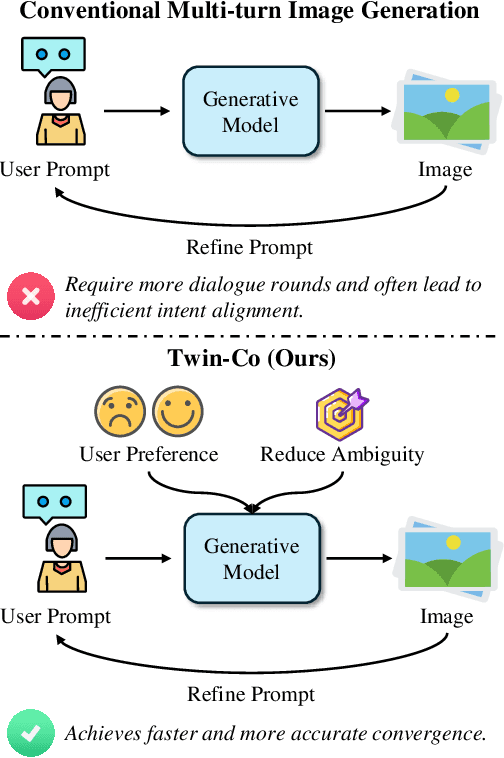
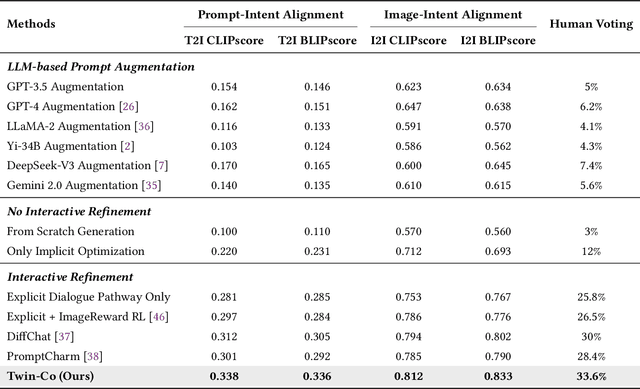
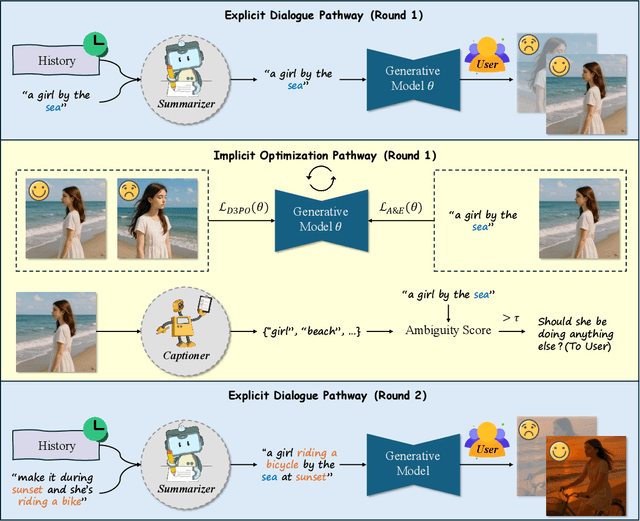

Abstract:Modern text-to-image generation systems have enabled the creation of remarkably realistic and high-quality visuals, yet they often falter when handling the inherent ambiguities in user prompts. In this work, we present Twin-Co, a framework that leverages synchronized, co-adaptive dialogue to progressively refine image generation. Instead of a static generation process, Twin-Co employs a dynamic, iterative workflow where an intelligent dialogue agent continuously interacts with the user. Initially, a base image is generated from the user's prompt. Then, through a series of synchronized dialogue exchanges, the system adapts and optimizes the image according to evolving user feedback. The co-adaptive process allows the system to progressively narrow down ambiguities and better align with user intent. Experiments demonstrate that Twin-Co not only enhances user experience by reducing trial-and-error iterations but also improves the quality of the generated images, streamlining the creative process across various applications.
Kimi-VL Technical Report
Apr 10, 2025

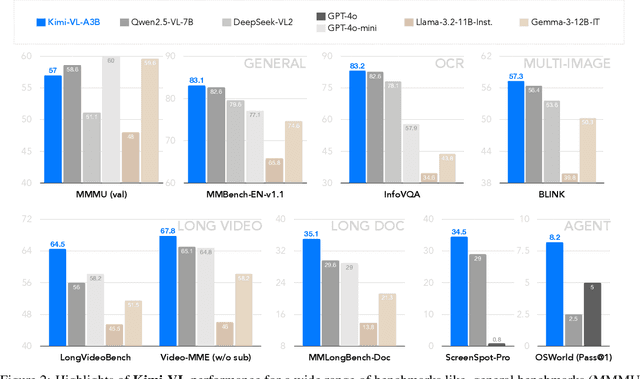

Abstract:We present Kimi-VL, an efficient open-source Mixture-of-Experts (MoE) vision-language model (VLM) that offers advanced multimodal reasoning, long-context understanding, and strong agent capabilities - all while activating only 2.8B parameters in its language decoder (Kimi-VL-A3B). Kimi-VL demonstrates strong performance across challenging domains: as a general-purpose VLM, Kimi-VL excels in multi-turn agent tasks (e.g., OSWorld), matching flagship models. Furthermore, it exhibits remarkable capabilities across diverse challenging vision language tasks, including college-level image and video comprehension, OCR, mathematical reasoning, and multi-image understanding. In comparative evaluations, it effectively competes with cutting-edge efficient VLMs such as GPT-4o-mini, Qwen2.5-VL-7B, and Gemma-3-12B-IT, while surpassing GPT-4o in several key domains. Kimi-VL also advances in processing long contexts and perceiving clearly. With a 128K extended context window, Kimi-VL can process diverse long inputs, achieving impressive scores of 64.5 on LongVideoBench and 35.1 on MMLongBench-Doc. Its native-resolution vision encoder, MoonViT, further allows it to see and understand ultra-high-resolution visual inputs, achieving 83.2 on InfoVQA and 34.5 on ScreenSpot-Pro, while maintaining lower computational cost for common tasks. Building upon Kimi-VL, we introduce an advanced long-thinking variant: Kimi-VL-Thinking. Developed through long chain-of-thought (CoT) supervised fine-tuning (SFT) and reinforcement learning (RL), this model exhibits strong long-horizon reasoning capabilities. It achieves scores of 61.7 on MMMU, 36.8 on MathVision, and 71.3 on MathVista while maintaining the compact 2.8B activated LLM parameters, setting a new standard for efficient multimodal thinking models. Code and models are publicly accessible at https://github.com/MoonshotAI/Kimi-VL.
RaSeRec: Retrieval-Augmented Sequential Recommendation
Dec 24, 2024

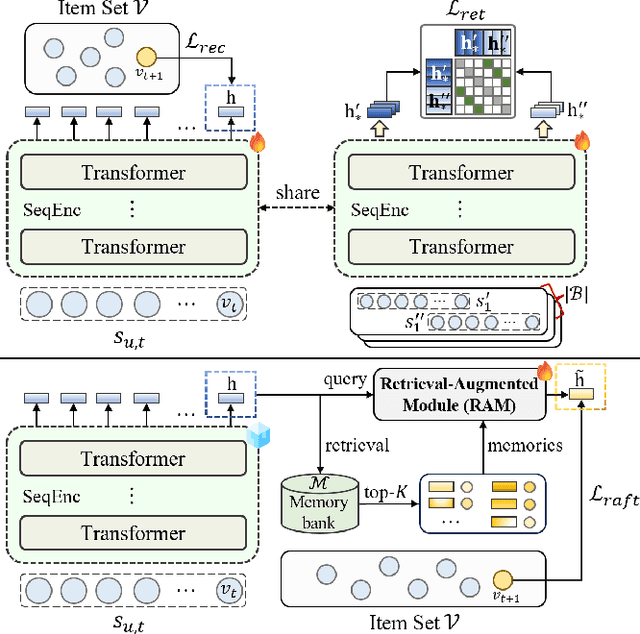
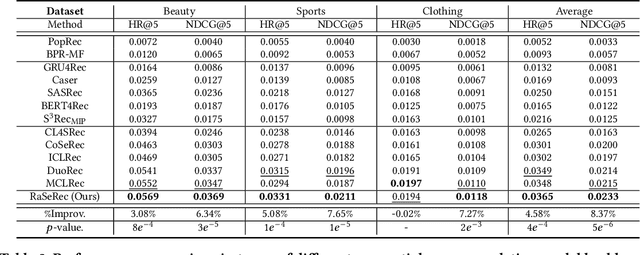
Abstract:Although prevailing supervised and self-supervised learning (SSL)-augmented sequential recommendation (SeRec) models have achieved improved performance with powerful neural network architectures, we argue that they still suffer from two limitations: (1) Preference Drift, where models trained on past data can hardly accommodate evolving user preference; and (2) Implicit Memory, where head patterns dominate parametric learning, making it harder to recall long tails. In this work, we explore retrieval augmentation in SeRec, to address these limitations. To this end, we propose a Retrieval-Augmented Sequential Recommendation framework, named RaSeRec, the main idea of which is to maintain a dynamic memory bank to accommodate preference drifts and retrieve relevant memories to augment user modeling explicitly. It consists of two stages: (i) collaborative-based pre-training, which learns to recommend and retrieve; (ii) retrieval-augmented fine-tuning, which learns to leverage retrieved memories. Extensive experiments on three datasets fully demonstrate the superiority and effectiveness of RaSeRec.
SEER: Self-Aligned Evidence Extraction for Retrieval-Augmented Generation
Oct 15, 2024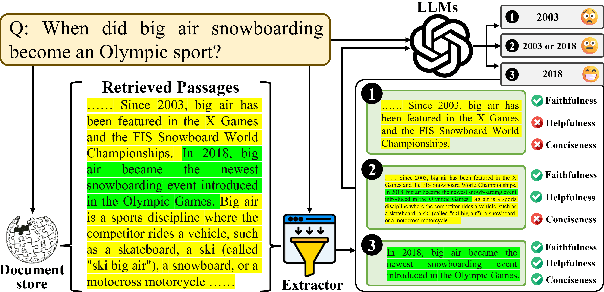
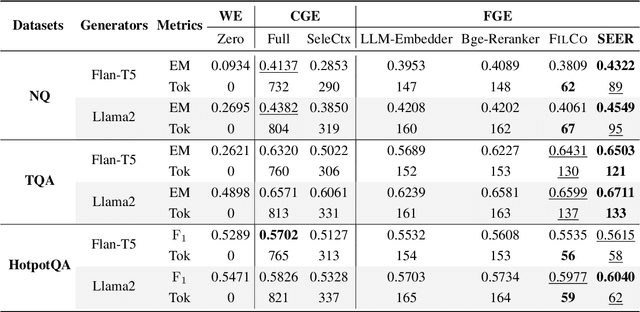
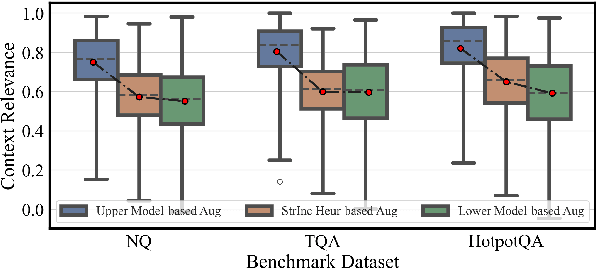
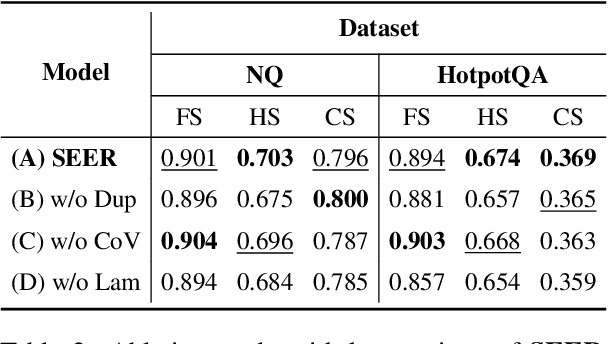
Abstract:Recent studies in Retrieval-Augmented Generation (RAG) have investigated extracting evidence from retrieved passages to reduce computational costs and enhance the final RAG performance, yet it remains challenging. Existing methods heavily rely on heuristic-based augmentation, encountering several issues: (1) Poor generalization due to hand-crafted context filtering; (2) Semantics deficiency due to rule-based context chunking; (3) Skewed length due to sentence-wise filter learning. To address these issues, we propose a model-based evidence extraction learning framework, SEER, optimizing a vanilla model as an evidence extractor with desired properties through self-aligned learning. Extensive experiments show that our method largely improves the final RAG performance, enhances the faithfulness, helpfulness, and conciseness of the extracted evidence, and reduces the evidence length by 9.25 times. The code will be available at https://github.com/HITsz-TMG/SEER.
FunnelRAG: A Coarse-to-Fine Progressive Retrieval Paradigm for RAG
Oct 14, 2024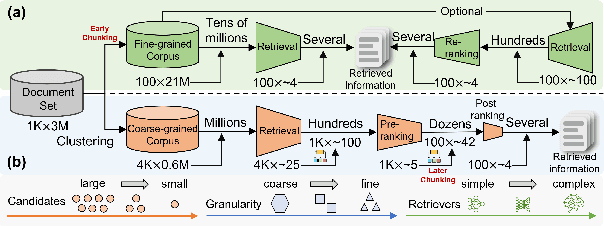

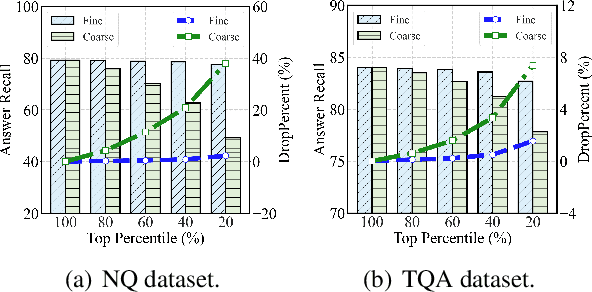
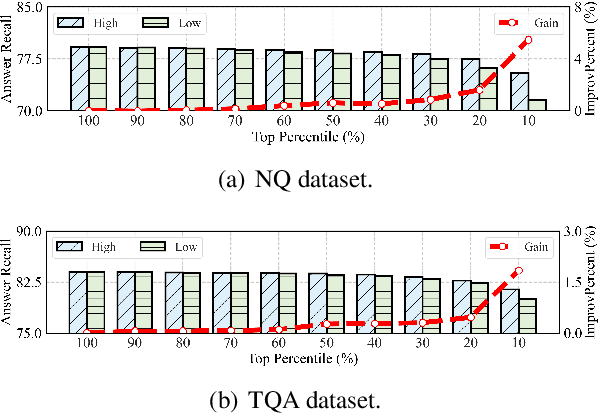
Abstract:Retrieval-Augmented Generation (RAG) prevails in Large Language Models. It mainly consists of retrieval and generation. The retrieval modules (a.k.a. retrievers) aim to find useful information used to facilitate generation modules (a.k.a. generators). As such, generators' performance largely depends on the effectiveness and efficiency of retrievers. However, the retrieval paradigm that we design and use remains flat, which treats the retrieval procedures as a one-off deal with constant granularity. Despite effectiveness, we argue that they suffer from two limitations: (1) flat retrieval exerts a significant burden on one retriever; (2) constant granularity limits the ceiling of retrieval performance. In this work, we propose a progressive retrieval paradigm with coarse-to-fine granularity for RAG, termed FunnelRAG, so as to balance effectiveness and efficiency. Specifically, FunnelRAG establishes a progressive retrieval pipeline by collaborating coarse-to-fine granularity, large-to-small quantity, and low-to-high capacity, which can relieve the burden on one retriever and also promote the ceiling of retrieval performance. Extensive experiments manifest that FunnelRAG achieves comparable retrieval performance while the time overhead is reduced by nearly 40 percent.
MSSDA: Multi-Sub-Source Adaptation for Diabetic Foot Neuropathy Recognition
Sep 21, 2024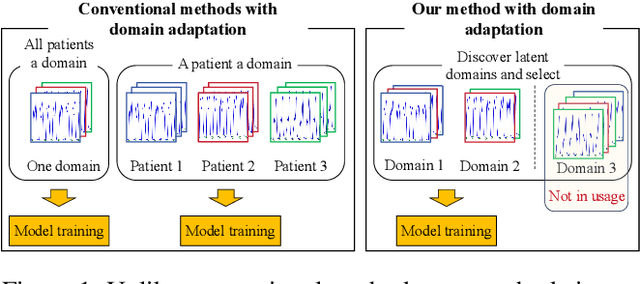
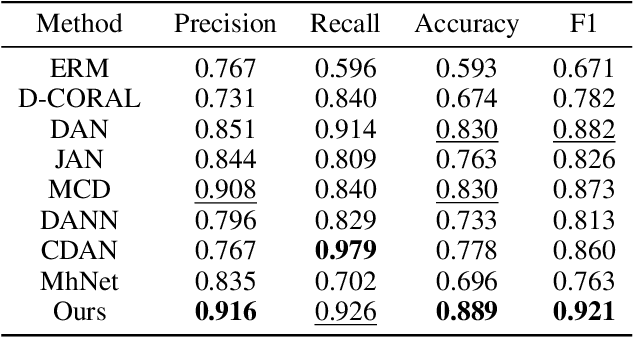
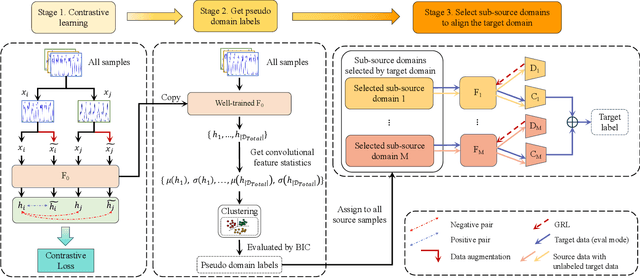
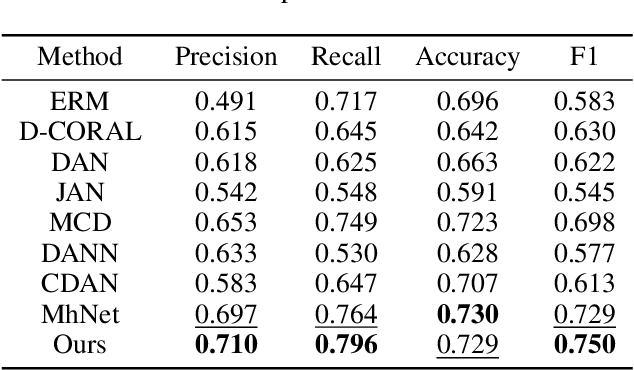
Abstract:Diabetic foot neuropathy (DFN) is a critical factor leading to diabetic foot ulcers, which is one of the most common and severe complications of diabetes mellitus (DM) and is associated with high risks of amputation and mortality. Despite its significance, existing datasets do not directly derive from plantar data and lack continuous, long-term foot-specific information. To advance DFN research, we have collected a novel dataset comprising continuous plantar pressure data to recognize diabetic foot neuropathy. This dataset includes data from 94 DM patients with DFN and 41 DM patients without DFN. Moreover, traditional methods divide datasets by individuals, potentially leading to significant domain discrepancies in some feature spaces due to the absence of mid-domain data. In this paper, we propose an effective domain adaptation method to address this proplem. We split the dataset based on convolutional feature statistics and select appropriate sub-source domains to enhance efficiency and avoid negative transfer. We then align the distributions of each source and target domain pair in specific feature spaces to minimize the domain gap. Comprehensive results validate the effectiveness of our method on both the newly proposed dataset for DFN recognition and an existing dataset.
 Add to Chrome
Add to Chrome Add to Firefox
Add to Firefox Add to Edge
Add to Edge